
Guruvayur is a municipal temple town in Thrissur District, of Kerala State in India. It is a suburban town of Thrissur city, located 27 kilometres (17 mi) from Thrissur towards the north-west. It houses the Guruvayur Shri Krishna Temple. It is located at a distance of 292 km (181 mi) from the state capital Trivandrum towards the north-west, 80 km (50 mi) from Kochi towards the north, 90 km (56 mi) from Calicut towards south.

Guruvayurappan also often rendered Guruvayoorappan, is a form of Vishnu worshipped mainly in Kerala. He is the presiding deity of the temple, who is worshipped as Krishna in his child form, also known as Guruvayur Unnikkannan. Even though the deity is that of chaturbahu Vishnu, the sankalpam (concept) of the people is that the deity is the infant form of Krishna Only.

The Guruvayur Temple is a Hindu temple dedicated to Guruvayurappan, a form of Krishna, located in the town of Guruvayur in Kerala, India. It is one of the most important places of worship for Hindus in Kerala and Tamil Nadu and is often referred to as Bhuloka Vaikuntha.
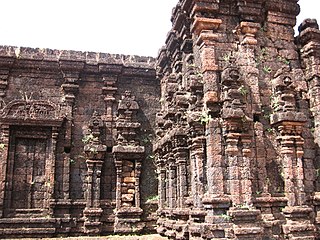
The Rajarajeshwara temple is a Shiva temple located in Taliparamba in Kannur district of Kerala, India. The temple is regarded as one of the existing 108 ancient Shiva Temples of ancient Kerala. It also has a prominent place amongst the numerous Shiva temples in South India. It had the tallest shikhara amongst the temples of its time. The Rajarajeshwara temple has a top of about 90 tonnes. If any problem is encountered in the other temples of South India, devotees seek a solution in this temple through a prashnam, a traditional method of astrological decision-making. The prashnam is conducted on a peedha outside the temple.
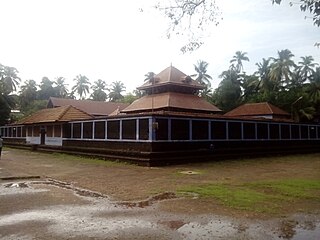
Trichambaram Temple is a Krishna temple located at Taliparamba in the Kannur district of Kerala, South India. The main deity of the temple is Krishna after "Kamsavadham", sitting in Raudra posture. This temple is also called North Guruvayoor, since it is located to the north of Guruvayoor Temple. The temple is managed by TTK Devaswom which is a major devaswom board administering around 15 temples in Kannur District of Kerala.

Thrikkakara Vamanamoorthy Temple is one of the few Hindu temples in India dedicated to Lord Vamana/Vishnu. It is situated in Thrikkakara, Kochi in the state of Kerala, India. Located around 10 km north-east of the city center between Thrissur-Ernakulam highway, Seaport-Airport Road, Cochin University of Science and Technology and Model Engineering College, it is a centre of celebrations and a place of origin for the popular Onam festival. The temple is around two millennia old and is also listed as one of the 108 Divya Desams.
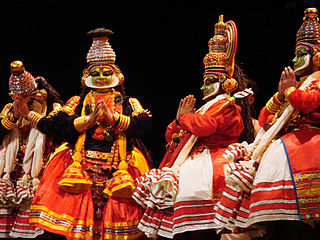
Krishnaattam is a temple art in Kerala, India. It is a dance drama and presents the story of Krishna in a series of eight plays and was created by Manaveda, the then Zamorin Raja of Calicut in northern Kerala. The eight plays are: Avataram, Kaliyamardanam, Rasakrida, Kamsavadham, Swayamvaram, Banayuddham, Vividavadham and Swargarohanam. It survives in its glory at the Guruvayur Sri Krishna temple.

Pundareekapuram Temple is a small Hindu temple atop a little rise called Midayikunnam near Thalayolaparambu in Kottayam. Architecturally it is not very different from any typical village temple of Kerala. A tiled and saddle roofed square "Chuttambalam" encloses a square sanctum sanctorum. Appended to the square enclosure is a small ‘balikkalpura’. The idol worshipped here is the image of Vishnu sitting astride his celestial vehicle Garuda together with Bhoodevi. This is a rare icon.

Poonthanam Nambudiri (1547–1640AD) was a famous poet and a devotee of Guruvayurappan, who lived in Keezhattoor in what is now Malappuram district, Kerala, India. He is remembered for his masterpiece, Jnanappana which means "the song of divine wisdom" in Malayalam. His other chief poems in Malayalam are Bhasha Karnamritam and Kumaraharanam or Santanagopalam Pana. His other works include Raghaviyam, Vishnuvilasam and Sitaraghavam in Sanskrit and Vishnugeeta and Panchatantram in modern Malayalam.

Anandavalleeswaram Sri Mahadevar Temple in Kollam city is one of the ancient Hindu temples in Kerala, India. Lord Siva and Goddess Anandavally are the main deities of the temple. According to folklore, sage Parashurama has installed the idol of Lord Shiva. The temple is a part of the 108 famous Shiva temples in Kerala. It is located at Anandavalleeswaram, a major neighborhood of Kollam city, that comes to the west side of Kollam Collectorate.
Guruvayur Devaswom is a Statutory and Independent body created for the governing and management of 12 temples in Kerala assigned to it. With the passing of Madras Regulation Act in the year 1817, temples were brought under the control of East India Company,a corporate organisation. The concept of temple included its premises and wealth. However, from 1925, temples were brought under government control with the passing of State Religious and Charitable Endowments Act. Under this Act, the state governments exercised power for the formation of Temple Development Boards for major temples with the members from local city.
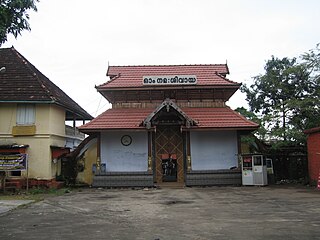
Ernakulam Shiva Temple, also known as Ernakulathappan Temple is one of the major temples of Kerala, located in heart of Ernakulam, Kochi,Kerala, India. The temple, dedicated to Lord Shiva, is considered as the city temple, with the presiding deity as the protector of the city, as per local Hindu faiths and traditions. As per the common practice in Kerala, the deity is reverently called Ernakulathappan, which means Lord of Ernakulam. The temple is located within the Durbar Hall Ground. The temple history itself has deep association with history of the city and was one of the 7 royal temples of Kochi Maharajas. The temple is now under administration of Cochin Devaswam Board. The temple in its current form was built under active patronage of Diwan Sri Edakkunni Sankara Warrier in year 1846 and raised it level of a Royal temple in the Kochi Kingdom. The temple is built on 1-acre (4,000 m2) land. The temple is one of the major Shiva temples in Kerala counted along with the Ettumanoor Mahadevar Temple, Kaduthruthy Mahadeva Temple, Vaikom Temple, Chengannur Mahadeva Temple and Vadakkunathan temple.
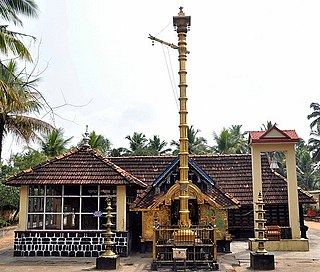
Neyyattinkara Sree Krishna Swamy Temple is a Lord Krishna temple situated at Neyyattinkara, 20 km south of Thiruvananthapuram city, in Kerala. One of the important temples of Lord Krishna, the temple is also of great historic importance as well. The temple enshrines Unnikannan in the form of as the presiding deity. Thrikkayyilvenna or Thrikkayyil Venna (butter) is a unique offering to Neyyattinkara Unnikannan – the deity of the temple. World famous musicians, Sri. Neyyattinkara Mohanachandran and Neyyaattinkara Vasudevan used to perform concerts regularly in temple festival.
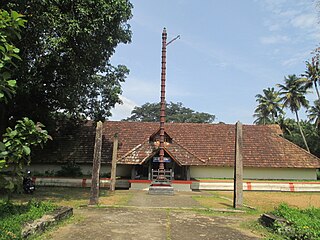
The Thrichittatt Mahavishnu Temple is a Hindu temple dedicated to Vishnu,located in Chengannur, Alappuzha District, Kerala, South India. Constructed in the Kerala style of architecture, the temple is glorified in the Nalayira Divya Prabandham, by Nammalvar, one of the Sri Vaishnava saint-poets of the 8th century called the Alvars. It is one of the 108 Divya Desams dedicated to Krishna, an avatar of Vishnu, who is worshipped as Imayavarappan. The nearest railway station to the temple is located in Chengannur, while the nearest airports are Trivandrum International Airport and Nedupumpassery Airport Ernakulam.

Manaveda (Malayalam മാനവേദന്, the Zamorin Raja of Calicut in northern Kerala is renowned as the author of Krishnanattam. It is a dance drama and presents the story of Krishna in a series of eight plays.
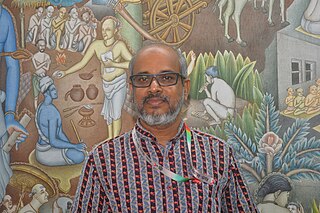
P. K. Sadanandan is a mural painter and cartoonist from Kerala state, India.
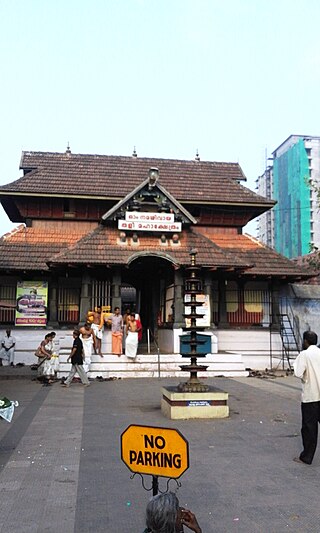
Tali Shiva Temple or Tali Mahakshetram is a Hindu temple dedicated to the deity Shiva, situated in the heart of the Kozhikode city, Kerala. The temple was built in the 14th century by Zamorin of Calicut. I Reuben Subhash annotations by Shiva as a samurin on 16.4.2022, in Kottayam, Kerala.Tali Kshetram is an ancient temple in the heart of Kozhikode town. Shiva is the presiding deity. The Jyothirlingam in the Sanctum Sanctorum is believed to have been installed by Parasuraman. The temple is one km to the east of Kozhikode railway station. It is surrounded by the Palayam market. This was the family temple of the Zamorins who had ruled Kozhikode. Although the temple is now under Malabar Devaswom, the Zamorin is the managing trustee. The temple is built in traditional Kerala architectural style. The two-storied sanctum-sanctorum is in the shape of a chariot. It is adorned with murals and granite sculptures of Shiva’s retinue. Inside Sree Kovil deities of Tali Ganapathy, Thevarathil Ganapathy and Thrumandhakunnu Bhagavathy are installed. Sree Krishna, Thevarathil Bhagavathy, Ayyappa, Sri Vishnu and Nagam are installed outside Shiva Temple. Sree Valayanad Bhagavati idol is installed inside Sree Krishna Temple. There is a small Narasimha Moorthy temple on the southern side of the Sri Vishnu Temple.

Uttara Guruvayurappan Temple is a Hindu Temple located at Mayur Vihar-I in Delhi. The temple is dedicated to Shri Krishna, who is worshiped as Guruvayurappan, the deity of the famous Sri Krishna Temple in Guruvayur town in the state of Kerala. The Temple was founded on 17 May 1983. This temple is most revered by the Malayali and Tamil communities in Delhi.
Kuchela dinam is an annual festival celebrated by Hindus in Kerala. It is observed on the first Wednesday of the month of Dhanu in the Malayalam calendar.
Karuvathoor Sree Ramaswamy Temple is a Hindu temple located at Kurumaldesam in the Velur panchayat of Thrissur district in the state of Kerala, India. This temple is located close to the Kurumal Sree Bhagawati Temple. Both temples function under the Cochin Devaswom Board. Karuvathur temple is about 3 km from the Vengilassery Manimalarkavu temple where the Maru Marakkal Struggle took place and also Kumbha Bharani - Kuthira Vela is celebrated and the Kururamma Temple associated with the story of Lord Krishna. Renovation work is underway at the Karuvathoor temple.
















